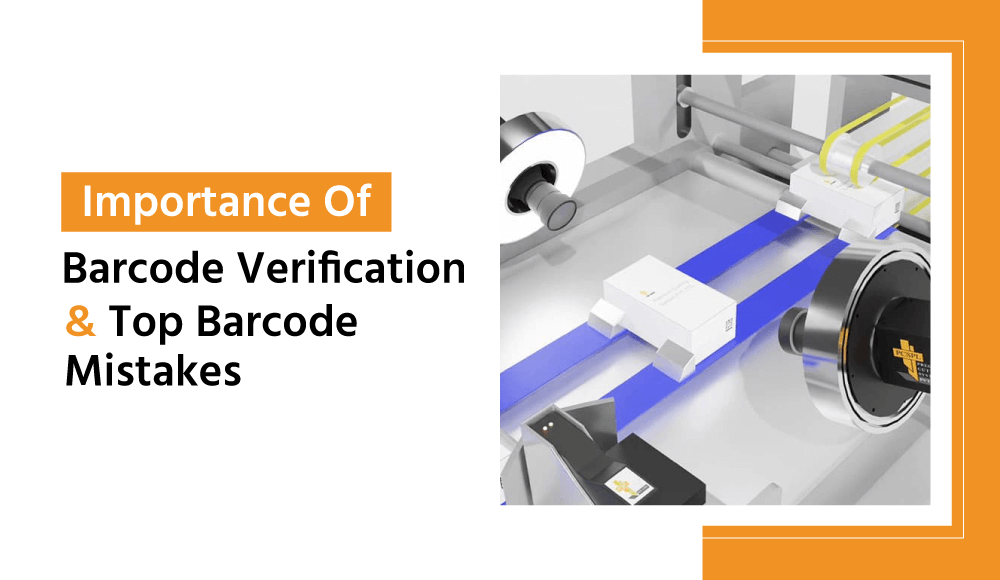
- Pixelwise Technology
- Dec 15, 2022
- Barcode Inspection
Barcodes are available everywhere. During the initial years of its invention, barcodes were helpful in tracking inventories and enabling supply chains. In the subsequent decades, the use cases of barcodes have evolved significantly. Today, they have gained even more popularity & the quality has only improved since then.
The process of barcode verification is all about due diligence. It involves the steps of meticulously testing as well as confirming that the particular barcode is performing optimally. Verifying barcodes is a complicated process in the entire supply chain. Barcodes that are readable indicate that the product is of high quality and eliminates the possibility of sending back the product.
There are several points of benefits of barcode verification. Let us understand the same in detail.
A] What is Barcode Verification?
Barcode verification defines the process of using a barcode verifier to identify or grade different barcodes. Barcode verifiers are capable of grading 2D barcode and 1D barcode. Comparing 1D and 2D barcode scanners to see which one suits your requirements is a vital part of the process. It will ultimately depend on the quality of the barcode according to the definition of the ISO standards. These standards are responsible for creating an ease of operation between the systems of barcode scanning and printing.
When a barcode is verified, there is a confirmation that a reader can accept the produced code in any location. It serves to be a highly effective method of grading the barcode while identifying and resolving common errors.
B] Why is It Important to Verify Barcodes?
There are several reasons to opt for using a dedicated barcode camera inspection system for printing and packaging. A barcode check that will not scan properly could lead to major problems from production downtime to manufacturing errors to fines and even product returns. Such failures can prove to be significantly costly as it will lead to expensive reprints, slower downlines, chargebacks, and even wasted products.
The process of barcode verification with the help of a reliable barcode tester helps in preventing these common issues. Some additional points of benefits are:
- Quality Control: The overall cost of reprinting as well as reshipping corrected products can be immensely expensive. Verification through a reliable barcode reader can help in alerting code producers about relevant printing issues quite early in the production process. As verification results can be monitored effectively, printers can go ahead with highlighting the problem areas of the code upon a decline in the overall quality. You can make use of a reliable visions system for inspection of barcodes.
Due to this, corrective action can be taken almost instantly. Successful barcode verification will make sure that a direct part marker or label is functioning properly. It also ensures that the codes are readable throughout the entire supply chain. Effective verification will help in minimizing the chances of product returns, packaging wastes, and additional expenses. - Customer Satisfaction: Rejection of material is a major expense that could minimize customer satisfaction and profitability. Barcode verification scanners that function properly prevent fines while avoiding errors due to manual entry.
- Industry and Contract Compliance: In addition to improving the quality of barcode, a barcode verifier is helpful in generating reports towards certifying the quality of codes of the producer. This is the reason why several regulated industries need that manufacturers leverage barcode verifiers.
- Minimizing the Costs of Reshipping: If the barcode does not scan, it is expected to be reprinted, repacked, and reshipped. This increases the overall product cost. Effective barcode verification will minimize the risks of wasted packaging and higher costs.
- We have shared below a short video of our barcode verification system that can accurately verify 1D codes at up to 35 scans per second.
Now that you have understood the importance of barcode verification, let’s take a look at the mistakes that you need to avoid.
C] Top 5 Avoidable Barcode Mistakes
Barcode mistakes can broadly be categorized into printing errors and design errors. It is crucial to eliminate both errors in the process of barcode verification. Some common errors to avoid in barcode verification are:
- Small BarcodeSize: All digital barcode artwork is expected to be created in the form of a vector image to help in maximizing the resolution of the barcode symbol while minimizing the file size. However, when the symbols are designed below 80 percent of the minimum size requirement, it will minimize space and bar width tolerances. This will make the job of the printer more complicated. Therefore, these symbols become difficult to scan.
- Poor Barcode Origination: Using the wrong file format like the. PNG will make the barcode difficult to scan. Converting or scaling a UPC file can affect the right sizing as well as bar patterns required for an effective scan. Some of the most common barcode formats that are acceptable easily are.EMF or. EPS.
- Wrong Barcode Number or Position: Scanning barcodes involving data tables and GS1 terminologies is quite confusing. Leading retailers will demand varying data lengths. Moreover, different systems might vary in terms of assigning and handling the check digit. Therefore, it is important to pay attention to the number and position of barcodes with the help of a reliable barcode tester.
- Wrong Color of the Bars and Spaces: In addition to the sizing of the barcodes, a graphic designer has the freedom to experiment with the colors of bars and spaces in a particular code. Specific color combinations might not simply function in the case of a barcode. Scanners need to work upon dark bars (depicting low reflectance) on a light background (depicting high reflectance).
- Placement Issues of Barcodes: In some cases, there is the issue of an unusual shape of the product that would ultimately lead to issues with barcode placements. Common placement issues feature tapes, folds, and over-labeling. You should go through and understand proper guidelines explaining the right placement of barcodes.
Conclusion
It is crucial that the overall format, print quality, and data of the barcode are accurate for automated systems to function properly. One of the best ways of verifying a barcode is by using a reliable barcode verifier. Usually, a scanner might fail in verifying specific codes. Also, a smartphone is not regarded as the best reliable source of barcode verification.
Verifiers help in understanding encoded information in a typical barcode. Therefore, it is imperative for you to trust a reliable barcode verifier from a reputed provider.
For more information on how barcode verification can help your business, you can contact us without any hesitation.
Ready to buy our Products?
Get in touch with our team – enquire now and get the answers to your questions!





